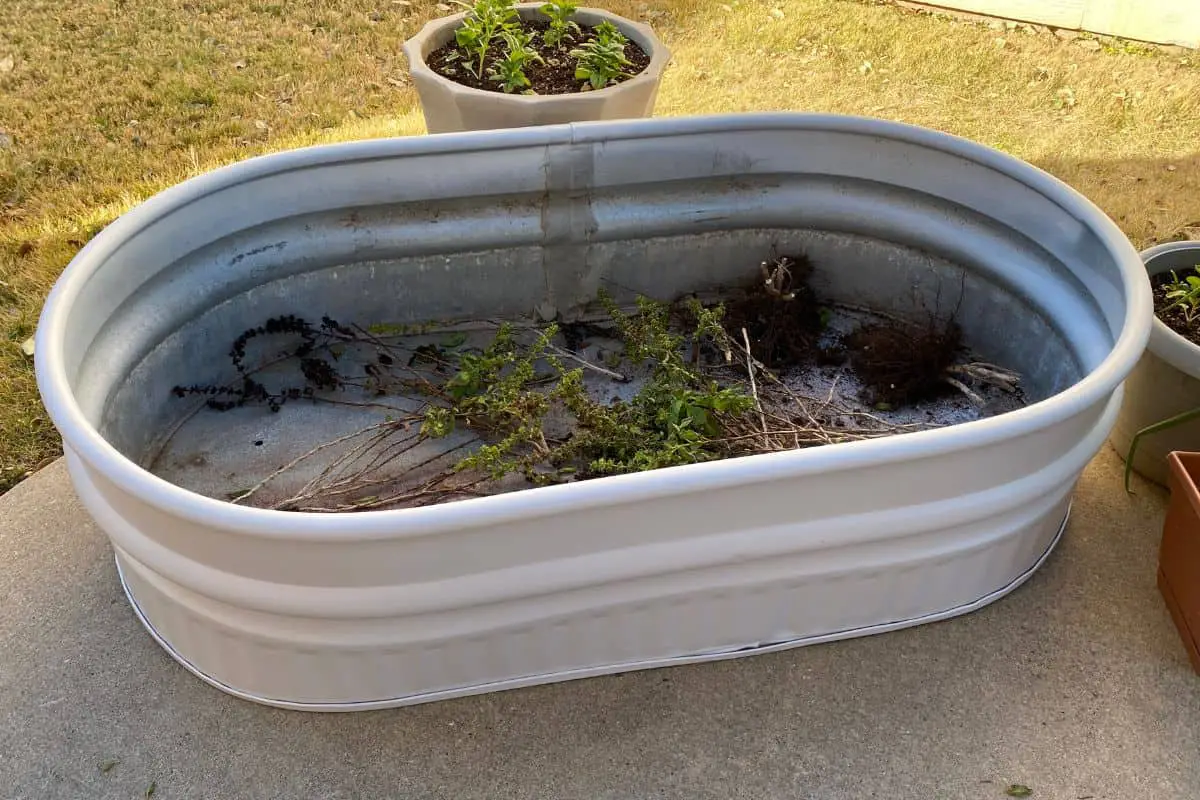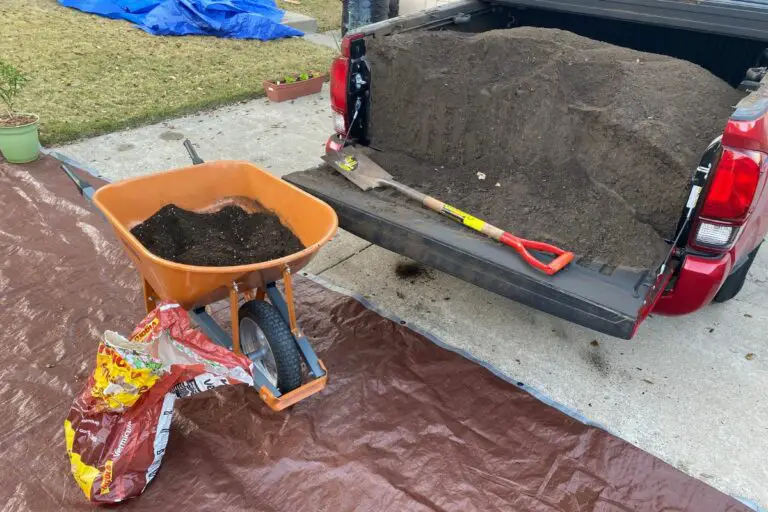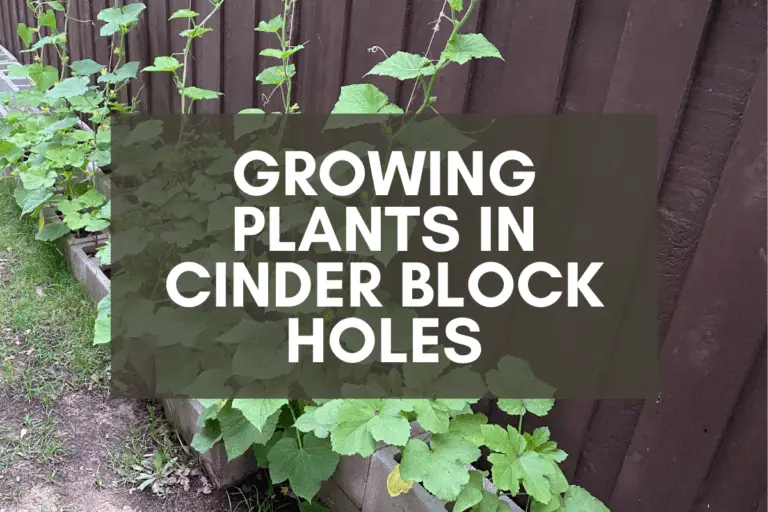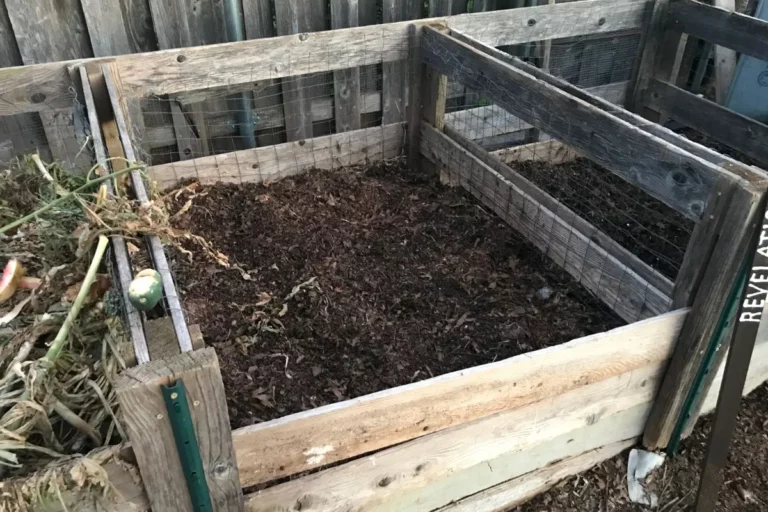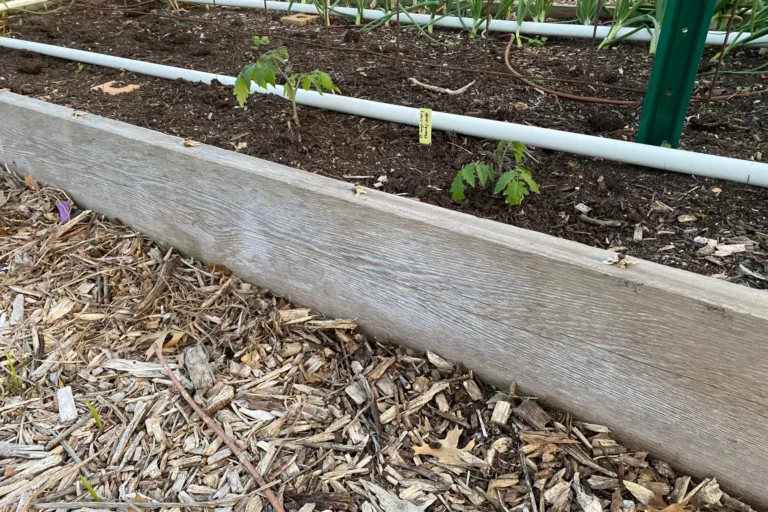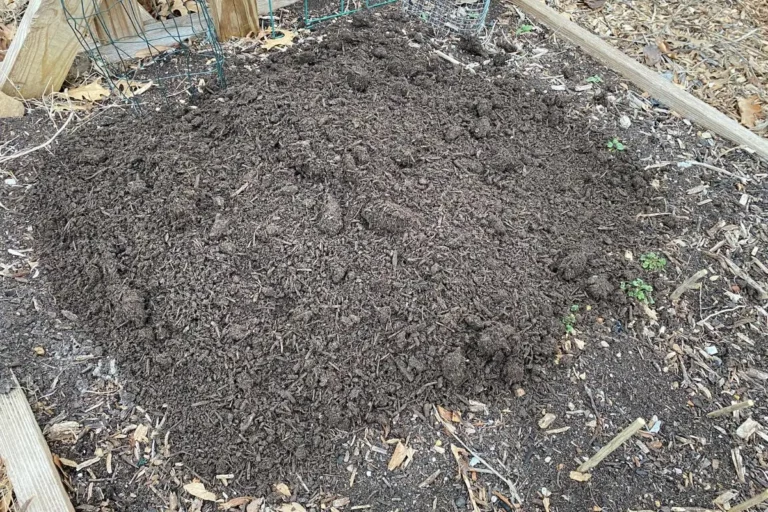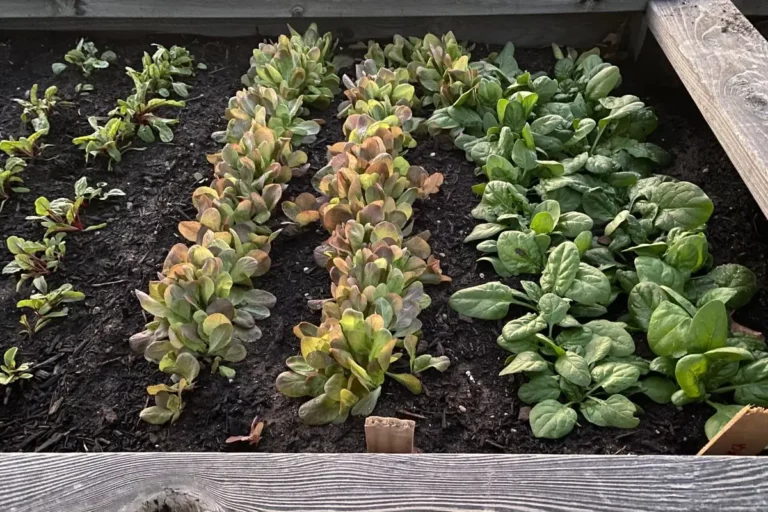18 Best Materials to Put in the Bottom of Your Raised Beds
If you’re interested in building or installing raised beds, you might be wondering how exactly you should fill them since, given their size or shape, you might need to add lots of materials before you can start gardening.
Should you fill it with soil or compost? Should you add sticks, branches, leaves, or other yard debris as well?
Most importantly, what goes in the bottom of raised garden beds to both save you money and ensure the best results?
The best materials to put in the bottom of raised garden beds are those that’ll add both carbon and nitrogen to the soil as they decompose: cardboard, branches and logs, leaves, manure, pine needles, and wood chips as well as coffee grounds, grass clippings, kitchen scraps, and old potting soil.
When considering what to put in the bottom of your raised garden bed, you need to think about more than merely what materials you’ll put to separate the native soil from the soil that’ll be in the bed itself.
If you’re trying to decide whether to line the bottom of your raised bed with cardboard, landscape fabric, hardware cloth, or even gravel, let’s take a moment to consider the bigger picture, not just what you should put at the very bottom of your raised beds.
That’s what I do in this article if you keep reading.
I’ll explain what I do to separate the native soil from my raised bed soil, then I’ll turn to the more important matter of what materials you should layer in the bottom of your raised beds for best results.
Disclosure: This post may contain affiliate links to some of my favorite products found on Amazon and other retail sites. I’ll earn a small commission from purchases made through those links, at no additional cost to you. Please read my product disclosure page to learn about the care I take when recommending products to my readers.
And if you happen to like any of the raised beds you see in my photos below, you can purchase them here:
- Vego raised garden beds: I love these beds. They’re pricey, but they’re probably going to last longer than I will! I own two of the, but I wish I had the room (and the money!) to buy many more.
- LuxenHome raised garden beds: I’ve got narrow areas of my yard where I needed narrower raised beds. These LuxenHome beds are perfect for anyone who’s got a small-ish backyard (like me).
- Tractor Supply Stock Tank: This is a great option if you’re wanting to garden atop concrete patios, asphalt, or other hard surfaces. I use a stock tank on my patio for my herb garden, and it’s fantastic. Simply drill holes in the bottom, and you’re good to go!
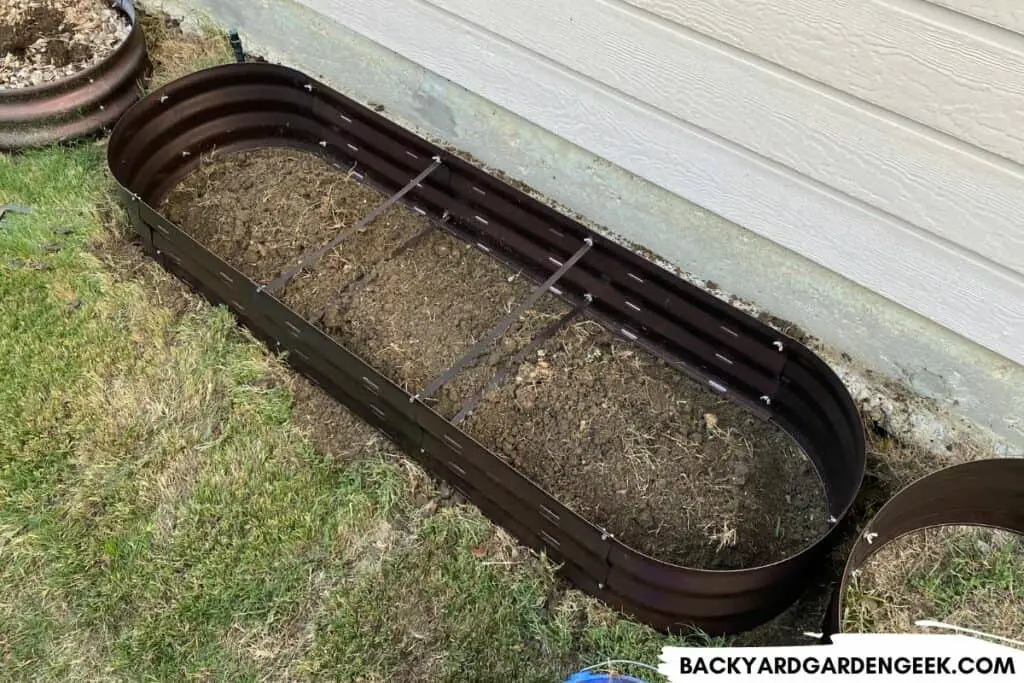
What Should I Put in the Very Bottom of Raised Beds?
Like me, you’re likely considering how best to build or install your new raised garden beds.
Should you put them on top of landscape fabric or hardware cloth? Should you put cardboard or newsprint at the bottom? What about plastic? Can plastic help keep weeds out of your raised beds?
Here’s what I think about the common materials you’ll read about when it comes to installing new raised beds:
1. Landscape Fabric
As a general rule, I’m not a fan of landscape fabric when it comes to raised garden beds (although I love it for mulched beds around my home!).
For beds around your house, driveway, or trees, go for it! But for garden beds, I think this is a big mistake since, unlike cardboard, landscape fabric will keep earthworms and other organisms out of your raised beds.
Unless you have a pressing reason why landscape fabric is a must, I’d encourage you to avoid it at all costs in your garden.
2. Hardware Cloth
Generally speaking, there’s no need for hardware cloth in the bottom of your raised beds with one key exception: critters.
If you’ve got burrowing animals in or around your property–specifically gophers, ground squirrels, moles, prairie dogs, or voles–then you definitely need hardware cloth.
Unlike landscape fabric, hardware cloth is a metal mesh material that’ll keep burrowing critters out of your garden.
But most importantly, it’ll allow worms, pill bugs, and other organisms to bypass the mesh and get up into the soil of your raised bed, which is definitely what you want.
3. Cardboard
For me, cardboard is the ideal material for the very bottom of your raised beds for several reasons.
First, if you put down thick layers of cardboard (2-3 layers is ideal), you’ll kill off native grasses, and you’ll ensure that weed seeds are smothered. Some grasses like Bermuda might eventually make a comeback–since Bermuda is to grass what roaches are to the insect world (basically unstoppable!)–but most grasses won’t be able to withstand a thick layer of cardboard.
Second, cardboard will eventually rot away. It’ll take months for cardboard to rot completely, but when it does, the native soil and the soil in your raised bed will have nothing separating them.
In fact, this is the third and most important reason to use cardboard: You want the organisms in your native soil to eventually make their way up into your raised garden beds.
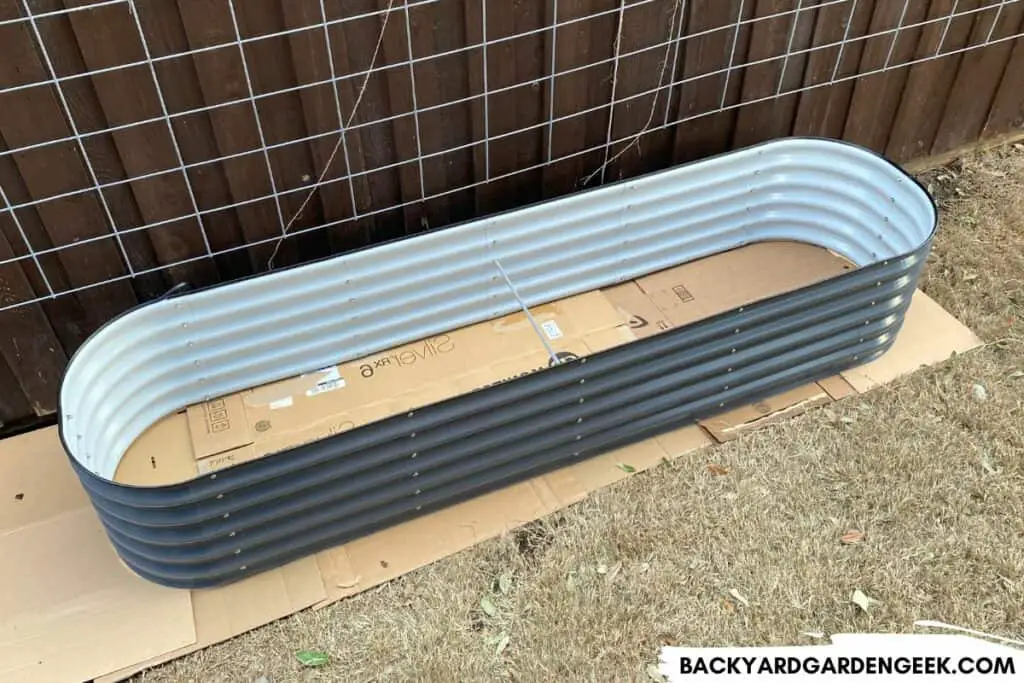
If you put a permanent barrier underneath your raised beds, earthworms and other important microorganisms will never be able to naturally migrate into your bed. Long term, your soil will suffer unless you regularly add worms and other beneficial organisms.
4. Gravel
I understand the theory behind putting gravel in the bottom of raised beds, but I sometimes wonder if people have ever actually tested out their theories in their backyards.
Here’s the thing: I’ve gardened in numerous raised beds over the years–including wood, metal, and cinder blocks–and I’ve never needed to use gravel. Ever.
As long as you install raised beds that have a decent depth to them and you fill those beds with the correct materials, you’ll have well-draining beds for years to come, so you won’t need to worry about putting gravel in the bottom of your raised beds.
5. Plastic
For me, this is a hard “no.” There’s just no reason why you need to line your beds with plastic unless you’ve got a small little patio planter and you want to ensure that water doesn’t drip out when you water your plants.
And even then, I just wouldn’t recommend plastic.
Here’s why: Plastic does absolutely nothing for your plants. It won’t decompose into organic material, it locks out soil-borne organisms by placing an impermeable barrier between your raised bed soil and your native soil, and it will slowly deteriorate over long periods of time, leaching trace amounts of chemicals into your soil.
Simply put, when you put cardboard and plastic side by side, there’s no contest. Cardboard is the clear winner.
Now that we’ve covered the materials that you might put underneath or along the ground of your raised beds, let’s take a close look at the many materials you can put in the bottom of your raised beds to encourage great soil development.
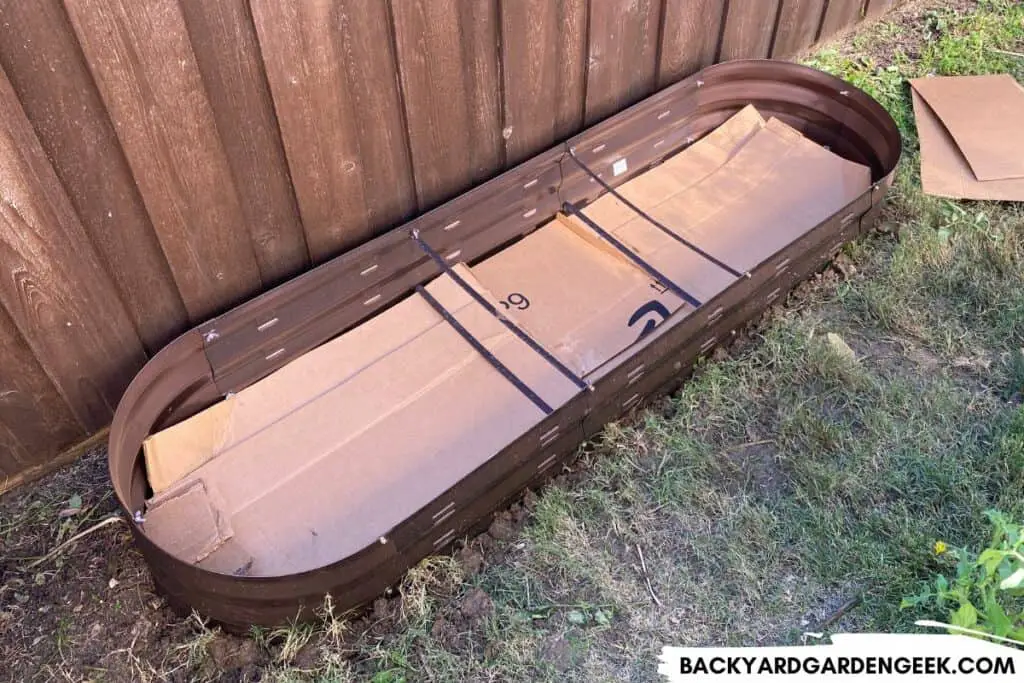
What Should I Put in a Raised Garden Bed Before Soil?
When it comes to building or installing new raised beds, I prefer to fill the bottom of mine with logs, branches, yard debris, and other compostable, organic materials.
If you do that, you’ll not only lay the foundation for future soil health by adding carbon- and nitrogen-rich materials, but you’ll also save lots of money by filling up as much as 50% of your raised beds for free instead of paying to fill the entire bed with compost and garden soil.
Some people refer to this as a version of “hugelkultur.” Others consider it a form of “lasagna gardening.”
Both are accurate descriptions for how I prep the bottoms of my raised beds. But I prefer to think of what I do in terms of economy and effectiveness.
If I fill my beds properly, I’m going to save a lot of money. And if I do so thoughtfully, I’m going to speed along the decomposition process and create the kind of soil that’ll attract native organisms and that my plants are going to thrive in.
But there are various mistakes to avoid when filling your raised garden beds for the first time.
If you want to get a full picture of my process, read below to learn the ins and outs of what I do so that you’ll learn from my mistakes and grow the very best plants possible in your new raised garden beds this year.
Before I provide a detailed explanation of everything you might consider putting in the bottom of a raised garden bed (plus mistakes you should avoid along the way), I want to share these insights with you:
- an alphabetical list of all of the materials I’ve put in the bottom of my raised garden beds.
- things to consider when filling new raised beds so as to produce nice, healthy soil.
- a hack for saving money while simultaneously growing whatever you want to grow in your new raised garden beds.

Alphabetized List of 18 Ideal Materials for Raised Beds
To begin with, here’s an alphabetized list of all the materials that I’ve put in the bottom of my raised garden beds at one point or another over the past 15 years.
(If you keep reading below, you’ll see detailed descriptions of why I use these materials and the mistakes you should avoid when doing so.)
- Banana Peels
- Branches
- Cardboard
- Compost (especially if it hasn’t yet decomposed)
- Eggshells
- Fish Scraps
- Coffee Grounds
- Flowers
- Grass Clippings (untreated + without seed heads + never Bermuda)
- Kitchen Scraps (anything that’s compostable)
- Leaves
- Livestock Manure (chicken, cow, goat, horse, llama, sheep)
- Logs
- Mulch (preferably non-dyed kinds)
- Newsprint (black and white, no colors)
- Pine Needles
- Potting Soil (used in last year’s containers)
- Wood Chips
Now that you’ve got a list of 18 things that you can place in the bottom of your raised beds, let’s take a quick look at exactly how I layer my beds.
I’ll also share a hack I use to fill my raised beds cheaply while also growing plants in them immediately.
Things to Consider When Filling New Garden Beds
Let’s start with what I think about when I look at an empty raised garden bed.
To begin, take a look at the depth of your raised beds. Whatever the depth–from 8 to 12 inches or 17-30 inches–divide the depth into 4 equal sections.
| Layer | % of Depth | Materials |
|---|---|---|
| Layer 4 | Top 25% | Soil |
| Layer 3 | Upper Middle 25% | Compost and Soil |
| Layer 2 | Lower Middle 25% | Coffee Grounds, Grass Clippings, Kitchen Scraps, Old Soil |
| Layer 1 | Bottom 25% | Logs, Branches, Leaves, Pine Needles, Wood Chips |
If you want to start growing plants immediately in your new raised beds, you’ll want to fill layers 1 and 2 with compostable materials but reserve layers 3 and 4 for nothing but high-quality compost and garden soil.
Filling the bottoms of your raised beds with materials that will slowly decompose is the most cost-effective way to prep new garden beds, but you’ll have to wait 8-12 months before the bed is fit for planting.
Filling the beds entirely with compost and garden soil is the quickest way to begin gardening in them, but it’ll also cost you more to do so.
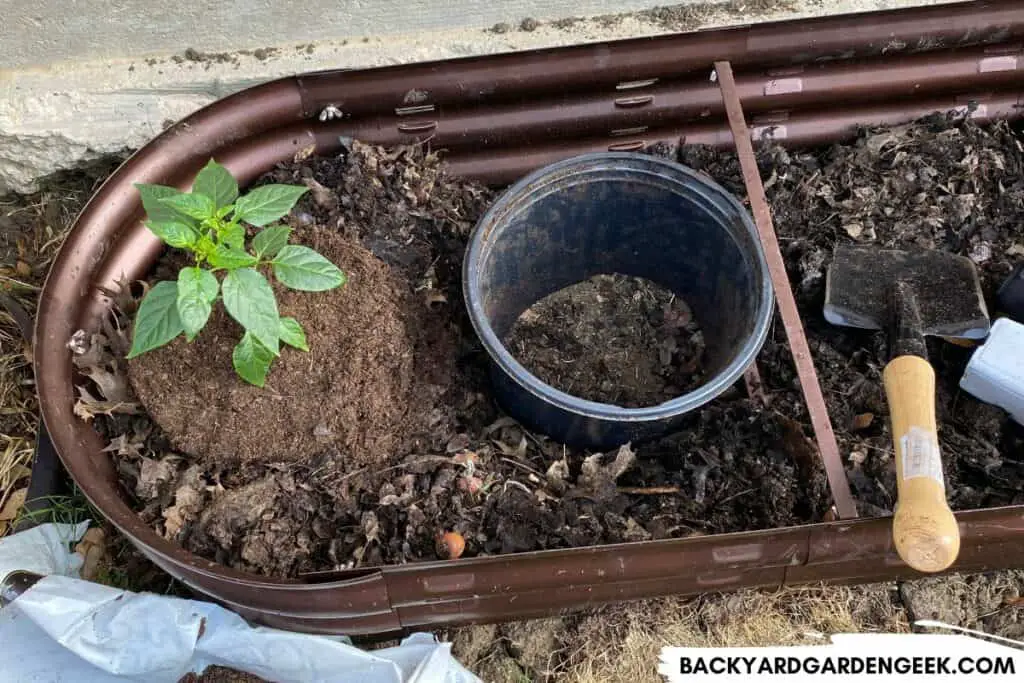
Filling Beds Cheaply While Gardening Immediately: My Backyard Hack
Before I provide more details about the materials that I put in the bottom of my raised beds, let me share a quick hack with you that’ll let you start growing larger plants immediately while also saving as much money as possible.
Here’s what you need to do:
Get your hands on some plastic containers. 3-5 gallon ones will work well (11-19 liters). Local garden centers sometimes have old ones lying around, but you can also purchase cheap containers or paint buckets.
Remove the bottoms of the containers, either using snips (for the cheap plastic ones) or a jigsaw tool (for the harder plastic used in paint buckets).
Place the containers in your garden bed, positioning them exactly where you’d like to grow eggplants, peppers, tomatoes, or any other large garden veggies.
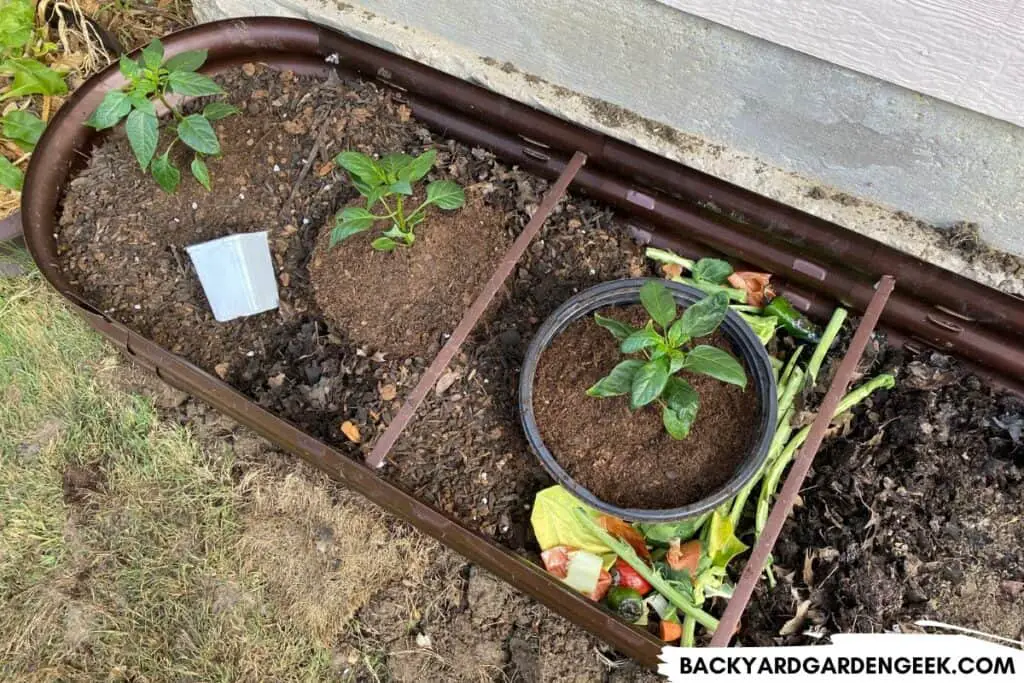
Fill the containers with soil to the same depth as your raised garden bed. If your bed is 12 inches, fill the container or bucket with enough soil to equal a depth of 12 inches (or more or less depending on how deep your bed is).
Leaving the buckets in place, fill up the remaining area in your newly installed raised beds with layer 1 and 2 materials. Put larger materials like logs and branches on bottom with smaller material such as leaves, pine needles, and wood chips on top.
Fill layers 3 and 4 with compost and soil to cover all of the materials you placed in layers 1 and 2.
Make sure everything is nicely compacted, then remove the buckets slowly, wiggling them as you go.
Plant your desired plants in the circular areas that are entirely soil, then cover over your entire raised bed with mulch or wood chips.
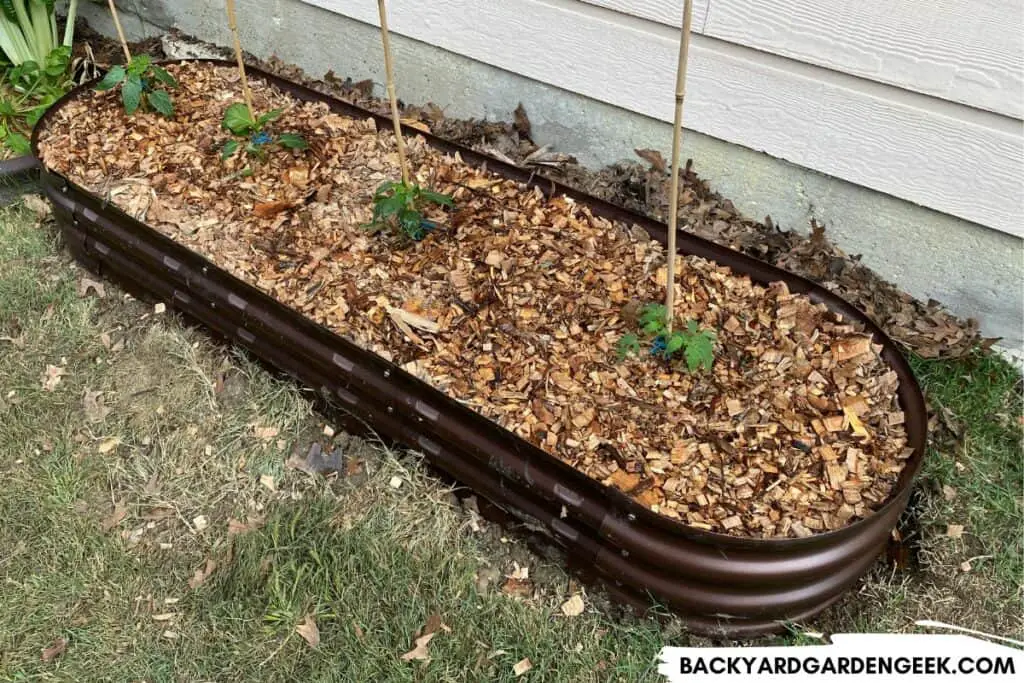
Using this method, I’ve grown pepper and tomato plants in brand new raised garden beds while also saving a ton of money by filling up the rest of the space with compostable debris from my yard as well as kitchen scraps.
18 Materials to Put in the Bottom of Raised Garden Beds
Now that we’ve gone over all of the basics as well as a hack that’s helped me many times over the years, let’s look at each of the 18 materials to see why exactly they’re ideal for the bottoms of raised garden beds.
1. Banana Peels
Calcium, magnesium, phosphorus, and potassium: Bananas have them all, which is why I throw as many banana peels as I can into the bottom of my raised garden beds.
Banana peel water isn’t quasi-magical, as some bloggers claim, but it’s accurate to say that decomposing bananas will be great for your garden soil over time.
2. Branches
The bigger the branch, the lower it goes when I’m filling up my raised garden beds.
Branches are a wonderful addition to the bottoms of raised beds. They take up lots of space, but they also decompose rather quickly.
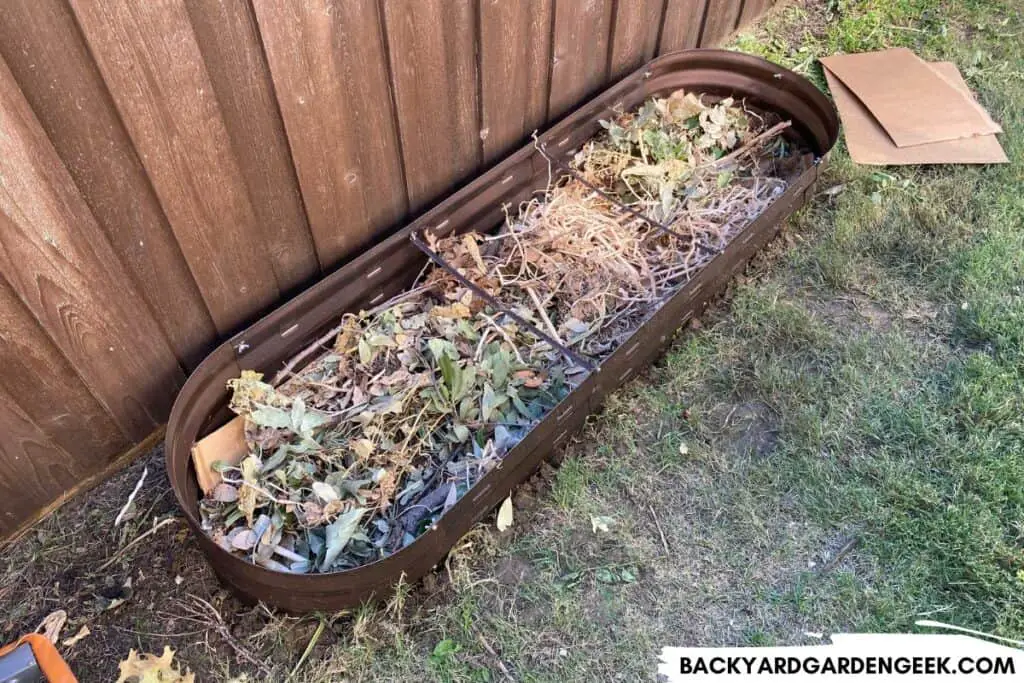
If you can get your hands on lots and lots of branches, fill the bottoms of your raised beds with them and cover them in smaller materials and soil. Within 6-8 months, those branches will begin transforming into beautiful garden soil.
3. Cardboard
Generally speaking, I think cardboard is the ideal material for the very bottom of your raised beds.
Be sure to layer it very thick. It’s also a good idea to let it poke out the sides of your raised beds so as to help kill of the native grass. But in just a few months, that cardboard will be gone, and your native organisms will have plenty of access to your raised bed soil.
4. Compost
If you’ve got a compost pile, heap plenty of compost into the bottom of your raised beds, especially if the compost hasn’t fully composted yet.
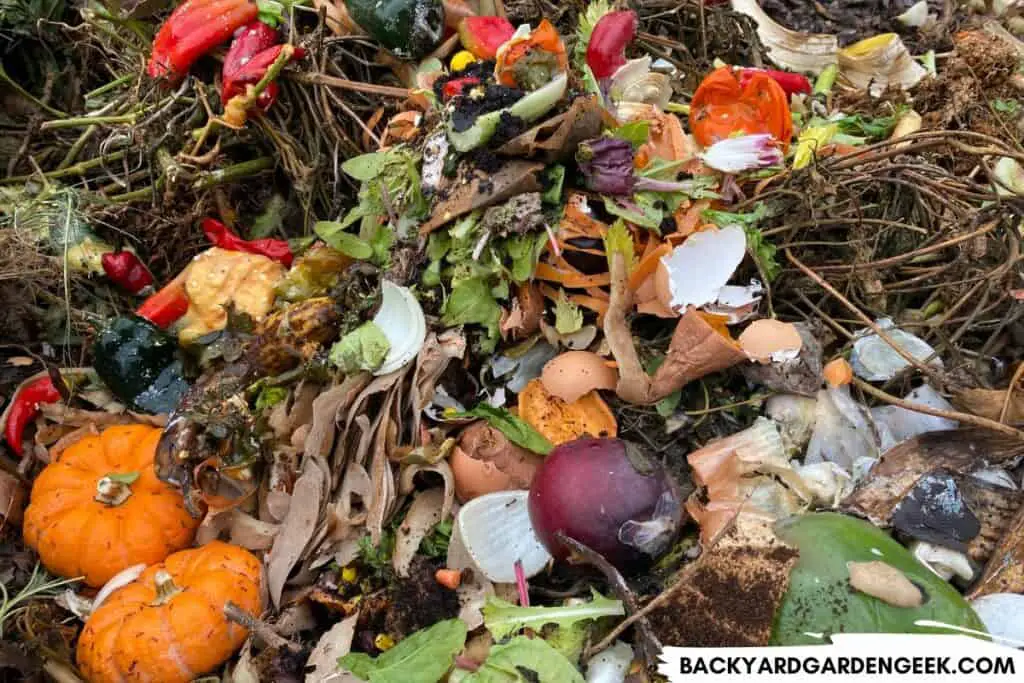
For larger compostable materials, make sure they’re at the very bottom of your raised beds since they’ll need longer to decompose. Finer compost can easily be added atop the larger stuff to help out with decomposition.
5. Eggshells
Eggshells are a great addition to the bottom of any raised bed. Just be sure to rinse them first before throwing them in. You’ll want to wash away the gel that remains after you’ve removed the yolk and egg whites.
6. Fish Scraps
Have you gone fishing recently or purchased whole fish at a local grocery store? Do you have leftover fish scraps after cleaning your fish?
If so, place those fish scraps in the bottom of your new raised beds. They’ll decompose nicely and provide some wonderful organic fertilizer for your veggies.
7. Coffee Grounds
Never add spent coffee grounds directly to an already existing raised bed. But you can definitely add them to the bottom of a new raised bed, where they’ll compost nicely over time.
8. Flowers
The same can be said for flowers. If you’ve got wilting flowers at home, toss them in the bottom of your raised bed!
They’ll decompose in no time at all (1-2 months) and provide extra nitrogen for the soil in your raised bed.
9. Grass Clippings
Grass clippings can be a great addition to the bottom of raised beds, with a few caveats.
Never add grass clippings if your yard has been treated for weeds, fire ants, or anything else. You don’t want those chemicals to end up in your garden beds.
Also, never add grass clippings if you’ve recently cut a yard that was filled with seed heads. Those grass seeds could cause you headaches later on!
Finally, never add Bermuda grass to any compost bin or raised bed. Bermuda grass is a rhizomatic grass, which means that any little piece of Bermuda grass can sprout and grow more grass.
The last thing you want is to put pieces of Bermuda grass in your raised beds. If you do that, you’ll be pulling out Bermuda grass for years to come. Yikes!
10. Kitchen Scraps
Do you have any compostable kitchen scraps? Add them to the bottom of your raised beds. The more, the merrier since kitchen scraps will decompose quickly and add some quality nutrients to your soil.
11. Leaves
If your trees have recently dropped their leaves, don’t just bag them up. Throw them in your raised beds!

Leaves can be used as mulch, but they’re also a great addition to the bottom of a raised bed since they’ll compact easily and decompose quickly.
12. Livestock Manure
When it comes to manure, the only manure you should add to your raised garden beds are those of farm animals: chicken, cow, goat, horse, llama, and sheep.
If you’ve got access to this kind of manure, you can add lots of it to the bottom layers of your raised beds since, over time, that manure will mix with all of the other materials you’re adding, leaving you with great soil.
Just don’t fill the bottoms of your beds with manure only. That’s a recipe for disaster since you need more of a balance when it comes to layering materials in your raised beds.
13. Logs
Logs are perfect if you’ve got deep raised beds. Definitely don’t add logs if your beds are only 8-12 inches deep.
But if you’ve got beds that are 17 inches deep or deeper, logs are a great way to fill up space while also adding a material that’ll compost down over time. It’ll take 12-18 months for logs to compost, but in deeper beds, that won’t matter because you can easily garden in top 12 inches of soil.
14. Mulch
As long as you’re using non-dyed mulches, you can add loads of mulch to the bottom of your raised beds. That mulch will decompose when covered with other layers, and it’ll make for good garden soil when it does.
15. Newsprint
If you still get newspapers, go ahead and save your black-and-white newsprint. You can add it to the bottom of raised beds as well since it’ll decompose quickly.
I wouldn’t do this with colored newsprint. There’s no telling what chemicals they might use when it comes to their newsprint dyes.
16. Pine Needles
Just like leaves, pine needs are great additions to the bottoms of raised beds since they’ll compact easily and decompose in 6-8 months.
If you’ve got pine trees on your property, don’t just throw those needles away. Toss them in your new raised beds and watch them turn into beautiful soil over time.
17. Potting Soil
Don’t ever put new potting soil in the bottoms of raised beds. That would be a major waste of money.
But if you’ve got used potting soil from old pots or containers–the kind of soil that’s been sitting around for the past 6-12 months–definitely throw it in your raised beds. It’ll aid the decomposition process and provide areas for earthworms to thrive.

18. Wood Chips
Wood chips are one of my all-time favorite additions to newly installed raised garden beds. They’re often quite small, since the chipping machines chop the wood up nicely, so they’ll decompose quickly.
They’re also great for mulching your raised beds after you’ve filled them with other materials.
If you live in an urban area, you can sign up at getchipdrop.com, and you’ll often get a load of wood chips dropped off on your driveway.
One word of warning: If you sign up for this service, expect lots of wood chips. You might want to partner with a neighbor before doing so since there’s a good chance that you’ll get too many wood chips for a single property.
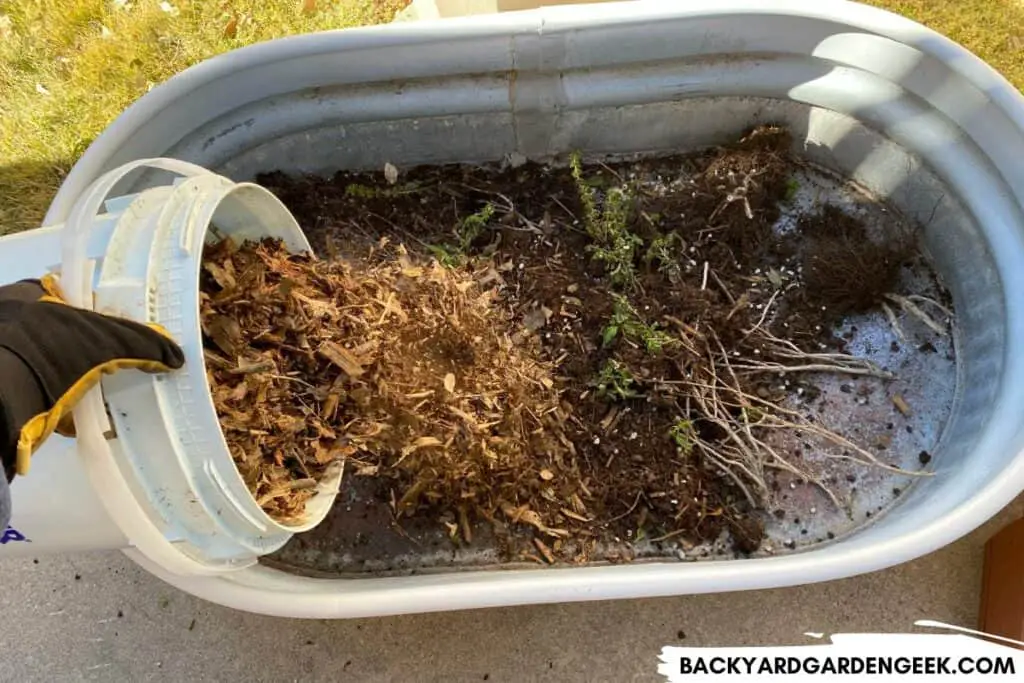
Additional Information
If you’ve enjoyed reading about raised garden beds, you might find these related articles interesting:
